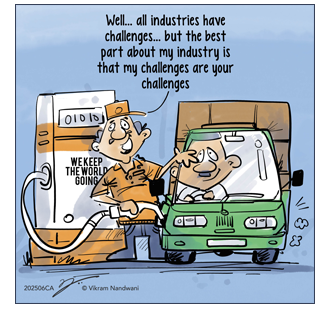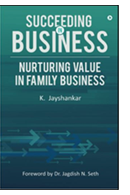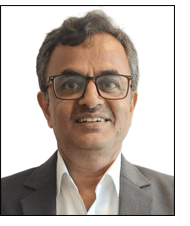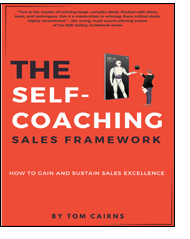|
|
Dear Reader,
Operating in the oil and gas industry - especially in India - requires more than business acumen; it demands grit, agility, and a deep understanding of an ecosystem shaped by public sector giants. With nearly 90% of the market held by state-owned oil companies, private players must not only deliver on performance but also navigate an environment where trust, compliance, and long-term relationship-building are non-negotiable.
 This edition of Customer Acumen focuses on the theme - The Oil Sector: Solving unique business challenges in an industry with public sector behemoths.
This edition of Customer Acumen focuses on the theme - The Oil Sector: Solving unique business challenges in an industry with public sector behemoths.
In his thought-provoking piece, Jay explores the unpredictable nature of crises in today's interconnected world. He argues that while businesses can plan for disruption, the true test lies in how reputational risk is managed when disaster strikes. Using recent, real-world examples, he reminds us that crisis communication must be proactive, not reactive - and that goodwill, once eroded, is painfully hard to rebuild.
In our Spotlight segment, Sudesh Menon, an industry veteran, walks us through the art and science of engaging with public sector oil companies. He shares how private players can carve out credibility through transparent pricing, digital innovation, strategic tendering, and relentless relationship-building. His insights shine a light on a high-stakes game where selling is far more than closing a deal - it's about trust, alignment, and delivering value over time. We also feature Tom Cairns' book on The Self-Coaching Sales Framework, which offers a refreshing and empowering take on sales development. Cairns, a veteran sales leader with decades of experience, proposes that the most sustainable path to sales excellence lies not in external training but in learning to coach oneself.
Our in-house Cartoonist, Vikram Nandwani's toon fuels solutions in a sector that keeps the world moving!
We value your relationship with us and look forward to your feedback and comments on how best we can serve you through our e-zine, Customer Acumen.
|

Out Now!
Succeeding in Business: Nurturing Value in Family Business
Click below to order your copy now

 

|
|
Special offer for Empowering Times readers. Get 30% discount by using coupon ETSPECIAL on the Notion Press online store.
Click here to connect with Jay.
|
|
|

|
The ultimate nightmare for a businessman is when a perfect storm hits your enterprise. Needless to add, no one enjoys a crisis, and most businesses would have drawn out a scenario of the kinds of crisis that could disrupt their operations and how they would tackle them. The insurance sector is built on selling this security option as an avenue to rebuild after disruption, particularly in cases of physical damage. Yet, when disruptions do occur, panic sets in and often the imagined danger causes more poor decisions than the damage caused by the intensity of the calamity.
Business disruption is a generic term that encompasses multiple causes. The standard ones that we are familiar with include business model or market disruption, technology shifts or digital transformations, and regulatory changes. Generally, the latter is easier to anticipate as signs that the government is changing policy is signaled well in advance, sometimes over a decade ahead (case in point, the curbs on the tobacco sector). However, business owners have been deeply impacted when overnight decisions have destroyed carefully created businesses, as witnessed in the early-70s when Indira Gandhi nationalized private banking and the coal industry with her hard turn to left wing politics.
Another nightmare scenario for a business is when an unimaginable accident brings them to their knees. Often attributed to an act of God, such accidents could be due to forces of nature (tsunami, hurricane, etc.), military action (remember the shooting of Malaysian Airlines plane over Ukraine), or human error (Bhopal, Chernobyl, Three Mile, etc.). The global airline industry has had a chequered history of such accidents and has risen like a phoenix time after time after each disaster. The recent tragedy in Ahmedabad is too fresh in our psyche and causes are under investigation. Economics apart, the blow is hard on Air India and ironically happened when they were in the midst of a public relations campaign to win back passenger trust in the airline. Since the airline's acquisition by the Tata group over three years ago, it has found itself under vicious attack from all quarters from its poor conditions, both on the ground and in the air, Air India faced criticism. The recent attempt to regain lost faith included a media campaign blitz. The inordinate delays in aircraft delivery from Boeing (enmeshed as it is in its own business troubles) has meant that the disrepute Air India was gaining had become a reputational risk to the Tata group too. The Ahmedabad accident now has become a gargantuan crisis that the Tata Group has to overcome and goes beyond any standard playbook response.
The domain of reputational risk is now widening from its traditional roots of financial risk management. It now lies at the intersection of marketing, public relations and finance laced with human behavior and corporate culture. The unbridled power of social media has challenged social norms like never before and it has become impossible to put a lid on negative stories that spiral out of control when disaster strikes.
The ask now for both governments and customer-facing businesses is to stay proactively vigilant in shaping beneficial public opinion towards itself, and its brands, as measures taken after disaster strikes are never enough. The government realized this after Operation Sindoor and was compelled to send global delegations to manage perceptions, just as Tatas will have to do now to recoup faith in their airline brand. However, crisis communication has severe limitations as the battle of optics is already lost. Time now to take a second look at the underappreciated concept of ‘Goodwill' in accounting.
back to top ^
|
|

|

Sudesh Menon brings extensive sales leadership experience in the oil and gas sector, driving business growth and customer engagement for Gilbarco Veeder-Root, a global leader in fueling products and fuel management solutions for retail, commercial, and industrial markets across India and the wider region.
An alumnus of IIT Kharagpur with a management degree, he has successfully led both start-ups and multinational corporations in India and abroad. Widely credited with pioneering the concept of sustainable community water systems in India, he served as Country Head of General Electric in Kuala Lumpur before returning to India in 2006 to lead WaterHealth India. There, he championed an innovative model providing safe drinking water to rural communities—a concept that gained national and global recognition. He later co-founded Waterlife, continuing his commitment to sustainable, impactful business solutions
CA. In your experience, how can private players build credibility and trust when working in sectors traditionally dominated by government bodies?
SM: The Oil and Gas retail sector has traditionally been dominated by PSUs Even today, ~90% is held by PSUs. Private players have emerged only in the last few decades. However, since all the PSU OMCs are legacy companies, new age private players can differentiate by placing themselves as technologically advanced, agile and innovative companies that provide superior customer experience. In this context, the following points would help establish credibility with customers and stakeholders:
- Competitive and transparent pricing - In India, fuel prices are primarily regulated by the government, with a substantial tax component contributing significantly to the overall cost borne by consumers. Given that India is a highly price-sensitive market and oil & gas are commodities, charging a higher price for fuel is counterproductive as it can adversely affect the credibility and can lead to greater customer churn. Hence clearly displaying fuel prices, taxes, and any additional charges can build transparency.
-
Leverage digital technology to build credibility - Utilize digital tools and platforms to promote transparency in all transactions and actively engage with customers through real-time feedback mechanisms with an integrated loyalty program. Data on customer behaviours can be utilized to personalize offers and communication.
- Product innovation - Private players can drive product innovation to support the government and oil companies' initiatives like Ethanol blending. They can also implement enhanced security features to minimise fraud and thus build trust with their consumers.
-
Marketing & Branding - Develop targeted marketing initiatives to highlight commitment to reliability, superior quality, and community engagement. Strengthen customer loyalty through well-designed rewards programs that incentivize repeat business. Also proactively invest in community upliftment projects to cultivate goodwill and implement environmentally friendly practices to build positive brand perception.
-
Regulatory and policy compliance - Consumers and stakeholders place their trust in businesses that strictly follow government regulations. Demonstrating full adherence to applicable laws, policies, and regulatory frameworks is essential for establishing and maintaining credibility within the industry. Private players are no exception.
CA. How is the business development process in the Oil sector different from other industries?
SM:
Oil sector is one of the eight core industrial sectors of India. Indian Oil sector is capital intensive and dominated by few big, consolidated players. In the downstream side, dealers are crucial channel partners to distribute oil to the end consumer. Although, oil retail companies and OEMs operate in typical B2B business environment, differs significantly.
- Majorly tender driven - Trio PSUs viz, IOCL, BPCL and HPCL control ~90% of the oil retail segment. Since they are government owned, they declare L1 on price basis. This gives rise to price war in suppliers, resulting in price erosion. In fact, price for retail outlet automation crashed in last decade due to huge price competition among automation service providers. This has affected quality of the products and solutions – as being L1 is the key criterion.
- Importance of pre-tender engagement - Business development often starts well before a tender is published. Understanding the customer's pain points, participating in pre-bid meetings, and proposing pilots or proof-of-concepts are essential to differentiate the product, introduce new specifications, and monetise the innovations.
-
Post tender engagement brings repeat business - The quality of execution and after-sales support plays a significant role. PSUs often look at past performance and adherence to SLAs while evaluating new proposals. So, business development doesn't end at order closure - it extends into delivery, support, and relationship nurturing.
-
Relationship Orientation - Oil & gas retail is a saturated market with just a few buyers and a few suppliers. It also exhibits a longer sales cycle and requires continuous engagement. As an OEM, we don't just sell a product - we build long-term trust and work to align with the PSU's technical, operational, and strategic goals over the long run.
- Channel partners are at the front line - COCO outlets are very few. Most retail outlets are owned and operated by dealers. Their conduct impacts the oil companies directly as they are key touchpoint for the end consumer. Moreover, ensuring compliance, safety norms, stopping any attempts at tampering with machines, avoiding payment leakages etc become important for oil companies and hence, important for OEMs.
CA. Tendering is a standard feature in government procurement. How then can principles of professional selling apply while doing business with the public sector?
SM: In the Oil & Gas PSU ecosystem, selling begins long before a tender is floated. As an OEM, we apply consultative selling and focus on building institutional trust at every step. In short, PSU tendering may formalize the process- Professional selling brings a human touch to the process through insight, integrity, and long-term commitment.
- Understanding the Customer's Needs (Consultative Selling): Even before a tender is floated, successful OEMs engage in understanding the PSU's operational challenges, regulatory pressures, and modernization goals. This insight allows us to influence the solutioning indirectly by anticipating requirements and aligning our offerings with their strategic roadmap.
- Relationship Building (Trust-Based Selling): In PSUs, relationships are built on credibility, long-term support, and reliability rather than aggressive sales tactics. By consistently delivering value, maintaining compliance, and responding quickly, we earn a reputation even during competitive bidding.
- Differentiation (Value Selling): Since price is often a significant factor, especially in L1-based tenders, the differentiation lies in how well the technical and commercial proposal is structured. This includes highlighting lifecycle cost benefits, ease of implementation, scalability, and post-sale service assurance-elements that are often considered during technical evaluation or negotiation phases.
- Influencing Specifications (Strategic Selling): Proactive engagement in pre-tender consultations, pilot projects, and proof of concept deployments gives us the opportunity to shape technical specifications in a way that aligns with industry best practices-an indirect but critical aspect of selling to PSUs.
- Credibility and Compliance (Trust and Ethics): Selling in the PSU environments is as much about being seen as a compliant, ethical, and process-driven organization as it is about the product itself. Our ability to navigate audits, furnish documentation, and meet quality, safety, and ESG criteria strengthens our sales position.
CA. Please give us two instances of how innovative steps were employed by you while resolving tricky situations in addressing customer needs in the government sector.
SM: One of the Oil OMC faced a problem from the pollution control board- they had to install Vapor-Recovery-enabled pumps – in locations where they had already supplied pumps without vapour recovery (vapour recovery of fuel fumes is a regulatory requirement for highly populated or high selling outlets). The OMC approached us, and we custom built an upgrade kit and retrofitted them at site. The OMC was thus able to meet regulatory requirements and avoid heavy penalties.
CA. Please share with us three learnings from your long and successful professional journey in different sectors while serving customers.
SM: Transparency and trust with customers are of utmost importance. Customers should trust that you will not shortchange them. In that case, even if we say something that is not of immediate benefit to the customer, they will know you have not tried to take advantage of them. Customers should know that you have their best in your heart.
Being a subject matter expert helps. Customers should come to us for any queries / challenges they might have – technical or commercial. It helps to occupy the top of mind in the customer's mind.
Keep meeting customers and socializing with them even during times when there is no requirement or sale. It should be a continuous relationship rather than one based on immediate need or requirement. Build long term and personal relationships.
|
|

|

A common thread in sales conversations today - whether in training rooms, performance reviews, or LinkedIn debates - is the frustration around underperformance despite all the right inputs. CRMs are in place, teams are trained, KPIs are defined, and yet something doesn't click. Why do so many smart sales teams fall short of their targets despite doing everything "right"? Tom Cairns' The Self-Coaching Sales Framework offers a compelling answer.
Cairns introduces a deceptively simple four-part loop: Reflect, Diagnose, Plan, Act. That's it. No fancy acronyms or overwrought metaphors. Just a deeply grounded framework that empowers sales professionals to become their own coach. And isn't that exactly what's missing in so many sales organizations today? A sense of personal agency?
The book begins by unpacking how sales, as a profession, has evolved-especially with the onslaught of AI, automation, and CRMs. Cairns doesn't vilify technology; rather, he highlights its limitations. One example that struck me was a cautionary tale involving an AI tool that transcribed discovery calls perfectly but failed to guide the seller to better decisions. It was a quiet reminder that data without discernment is noise.
In the chapters that follow, Cairns dives deep into the self-coaching process. He is clear-eyed in his assessment: most salespeople are doers. They pitch, they chase, they close - or try to. But few pause to ask why something worked, or more crucially, why it didn't. The "Reflect" and "Diagnose" stages of the framework are powerful in this regard, pushing professionals to step outside their execution mindset and think like strategists.
The book is peppered with real-world anecdotes - some of triumph, others of near misses-each illustrating how clarity, curiosity, and consistent introspection can elevate average performers into trusted advisors. In one chapter, Cairns recounts a scenario with a global construction company where AI gave the right advice, but only a human seller - armed with empathy and contextual intelligence - could navigate the final stretch to win the deal. It's a quiet ode to the irreplaceable role of human nuance in high-stakes sales.
Another strong point of the book is its treatment of planning - not as a once-a-quarter formality, but as a daily practice of purposeful prioritization. Cairns' emphasis on "micro-habits" feels especially relevant in a world obsessed with hacks and quick wins. It's a reminder that sales excellence, like fitness or music, is a craft built through repetition and self-honesty.
It's no surprise Cairns takes this long view. With a career that began in the 1970s at the dawn of the personal computer industry - where he consistently topped sales charts - he brings decades of hard-earned perspective. Over the years, he's led large international enterprises and built a reputation for developing scalable, performance - focused sales cultures. That experience permeates every page of the book, grounding the framework in lived wisdom rather than theory.
While Cairns focuses primarily on individual reps, he doesn't ignore leadership. A full chapter is dedicated to how managers can embed this self-coaching culture into team rhythms - transforming reviews from judgment days to growth conversations. His call to redefine success as "improvement over perfection" resonated with me as both timely and deeply humane.
The final chapters are among the strongest. Here, Cairns speaks directly to those who've been in the game long enough to know that the biggest threat to a good seller isn't competition - it's complacency. His solution is not a motivational high, but a steady rhythm of reflection, learning, and forward motion. As he puts it, "the goal is not to get it right once - it's to get better every time."
In terms of writing, the tone is clear and pragmatic, like a coach who's more interested in your progress than your perfection. No fluff. No hype. Just hard-earned wisdom shared generously.
Overall, The Self-Coaching Sales Framework is not a book you read once and shelve. It's a manual you revisit - especially after a tough quarter, a lost deal, or even a big win - because it reminds you that the best coach you'll ever have is the one who lives in your own head.
And maybe, just maybe, that's where the magic lies.
back to top ^
|
|
|
|
|
|